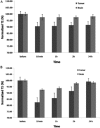Evaluation of brain tumor vessels specific contrast agents for glioblastoma imaging
- PMID: 22013169
- PMCID: PMC3245996
- DOI: 10.1093/neuonc/nor183
Evaluation of brain tumor vessels specific contrast agents for glioblastoma imaging
Abstract
A mouse model of glioblastoma multiforme was used to determine the accumulation of a targeted contrast agent in tumor vessels. The contrast agent, consisting of superparamagnetic iron oxide coated with dextran, was functionalized with an anti-insulin-like-growth-factor binding protein 7 (anti-IGFBP7) single domain antibody. The near infrared marker, Cy5.5, was also attached for an in vivo fluorescence study. A 9.4T magnetic resonance imaging (MRI) system was used for in vivo studies on days 10 and 11 following tumor inoculation. T(2) relaxation time was used to measure the accumulation of the contrast agent in the tumor. Changes in tumor to brain contrast because of active targeting were compared with a nontargeted contrast agent. Effective targeting was confirmed with near infrared measurements and fluorescent microscopic analysis. The results showed that there was a statistically significant (P < .01) difference in normalized T(2) between healthy brain and tumor tissue 10 min, 1 h, and 2 h point postinjection of the anti-IGFBP7 single domain antibody targeted and nontargeted iron oxide nanoparticles. A statistical difference remained in animals treated with targeted nanoparticles 24 h postinjection only. The MRI, near infrared imaging, and fluorescent microscopy studies showed corresponding spatial and temporal changes. We concluded that the developed anti-IGFBP7-iron oxide single domain antibody-targeted MRI contrast agent selectively binds to abnormal vessels within a glioblastoma. T(2)-weighted MRI and near infrared imaging are able to detect the targeting effects in brain tumors.
Figures



 MRI of a CD-1 nude brain tumor mouse model. (A) Before, (B) 20 min, (C) 1 h, and (D) 24 h postinjection of targeted (top row) and nontargeted (bottom row) superparamagnetic Fe3O4 nanoparticles. A gradient echo flow compensation method was used with the following parameters: FOV = 2 × 2 cm, slice thickness 1 mm, TR = 50 ms, TE = 7 ms, 50 kHz bandwidth, 15 degree flip angle and matrix size 128 × 128.
MRI of a CD-1 nude brain tumor mouse model. (A) Before, (B) 20 min, (C) 1 h, and (D) 24 h postinjection of targeted (top row) and nontargeted (bottom row) superparamagnetic Fe3O4 nanoparticles. A gradient echo flow compensation method was used with the following parameters: FOV = 2 × 2 cm, slice thickness 1 mm, TR = 50 ms, TE = 7 ms, 50 kHz bandwidth, 15 degree flip angle and matrix size 128 × 128.



Similar articles
-
Molecular imaging of glioblastoma multiforme using anti-insulin-like growth factor-binding protein-7 single-domain antibodies.Br J Cancer. 2010 Nov 9;103(10):1606-16. doi: 10.1038/sj.bjc.6605937. Epub 2010 Oct 19. Br J Cancer. 2010. PMID: 20959824 Free PMC article.
-
EGFRvIII antibody-conjugated iron oxide nanoparticles for magnetic resonance imaging-guided convection-enhanced delivery and targeted therapy of glioblastoma.Cancer Res. 2010 Aug 1;70(15):6303-12. doi: 10.1158/0008-5472.CAN-10-1022. Epub 2010 Jul 20. Cancer Res. 2010. PMID: 20647323 Free PMC article.
-
Small unilamellar vesicles: a platform technology for molecular imaging of brain tumors.Nanotechnology. 2011 May 13;22(19):195102. doi: 10.1088/0957-4484/22/19/195102. Epub 2011 Mar 24. Nanotechnology. 2011. PMID: 21436507
-
In vivo near-infrared fluorescence imaging of integrin alphavbeta3 in an orthotopic glioblastoma model.Mol Imaging Biol. 2006 Nov-Dec;8(6):315-23. doi: 10.1007/s11307-006-0059-y. Mol Imaging Biol. 2006. PMID: 17053862
-
Targeting experimental orthotopic glioblastoma with chitosan-based superparamagnetic iron oxide nanoparticles (CS-DX-SPIONs).Int J Nanomedicine. 2018 Mar 12;13:1471-1482. doi: 10.2147/IJN.S152461. eCollection 2018. Int J Nanomedicine. 2018. PMID: 29559776 Free PMC article.
Cited by
-
LyP-1 Conjugated Nanoparticles for Magnetic Resonance Imaging of Triple Negative Breast Cancer.Mol Imaging Biol. 2018 Jun;20(3):428-435. doi: 10.1007/s11307-017-1140-4. Mol Imaging Biol. 2018. PMID: 29101636
-
Insulin Growth Factor Binding Protein 7 (IGFBP7)-Related Cancer and IGFBP3 and IGFBP7 Crosstalk.Front Oncol. 2020 May 15;10:727. doi: 10.3389/fonc.2020.00727. eCollection 2020. Front Oncol. 2020. PMID: 32500027 Free PMC article. Review.
-
Nanobody-Based Probes for Subcellular Protein Identification and Visualization.Front Cell Neurosci. 2020 Nov 2;14:573278. doi: 10.3389/fncel.2020.573278. eCollection 2020. Front Cell Neurosci. 2020. PMID: 33240044 Free PMC article. Review.
-
Multifunctional nanoparticles for brain tumor imaging and therapy.Adv Drug Deliv Rev. 2014 Feb;66:42-57. doi: 10.1016/j.addr.2013.09.006. Epub 2013 Sep 20. Adv Drug Deliv Rev. 2014. PMID: 24060923 Free PMC article. Review.
-
Fe3O4 Magnetic Nanoparticles Obtained by the Novel Aerosol-Based Technique for Theranostic Applications.Materials (Basel). 2023 Sep 29;16(19):6483. doi: 10.3390/ma16196483. Materials (Basel). 2023. PMID: 37834621 Free PMC article.
References
-
- Sutherland GR, Florell R, Choi N, Sima AA. Epidemiology of primary intracranial neoplasms in Manitoba, Canada. Can J Neurol Sci. 1987;14:586–592. - PubMed
-
- Ohagaki H, Kleihues P. Population based studies on incidence, survival rates, and genetic alterations in astrocytic and oligodendrglial gliomas. J Neuropathol Exp Neurol. 2005;64(6):479–489. - PubMed
Publication types
MeSH terms
Substances
Grants and funding
LinkOut - more resources
Full Text Sources
Other Literature Sources
Medical
Miscellaneous

